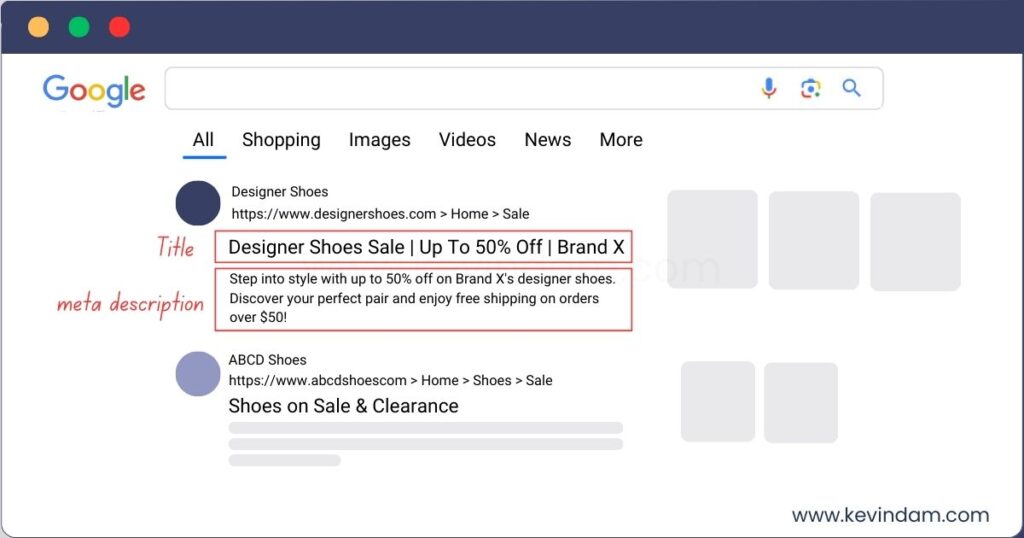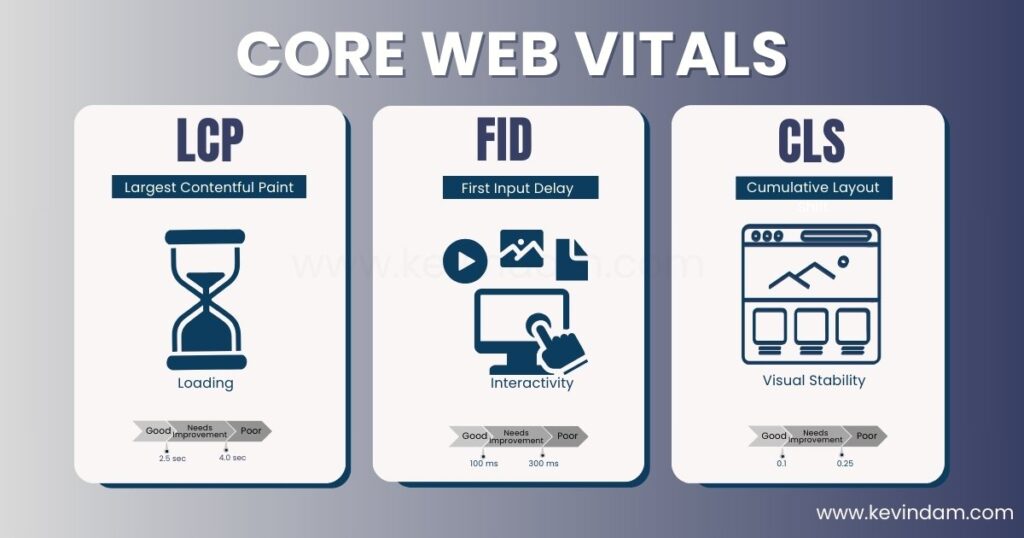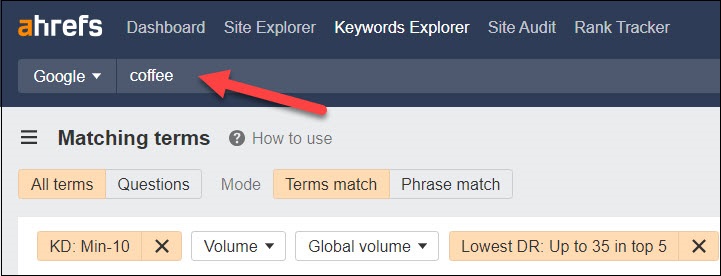
Last Updated August 15, 2024
SEO Tips for Better Rankings in 2024
Search Engine Optimization (SEO) significantly impacts businesses and website owners by boosting their visibility on the web and enhancing their rankings. However, ranking on the search engine results page is tougher than ever. Here are some effective SEO tips you can use for better rankings.
This article tackles SEO tips that will teach businesses and website owners how to improve their websites by conquering search engine results pages (SERPs) and attracting organic traffic.
1. Target the Right Keywords
Targeting the right keywords involves thorough keyword research to identify terms that are not only relevant to your content and audience but also those that strike the perfect balance between high search volume and low competition.
This process can be tricky, but here’s the process:
- Identify the Primary Keyword.
For example, Your main keyword is “coffee
- Use Keyword Research Tool for Keyword Suggestions
Keyword Research Tools like Google Keyword Planner or Ahrefs can be instrumental in this.

- Assess Search Volume
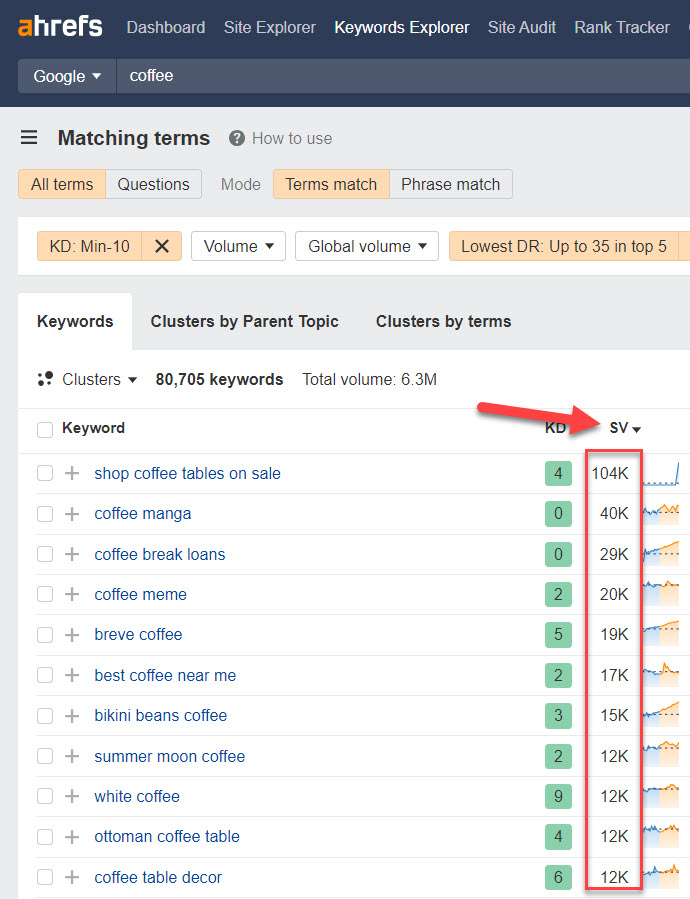
- Analyse Competition Level

- Select Target Keywords
You can also utilise the Include/Exclude Feature to select more relevant keywords depending on your topic.
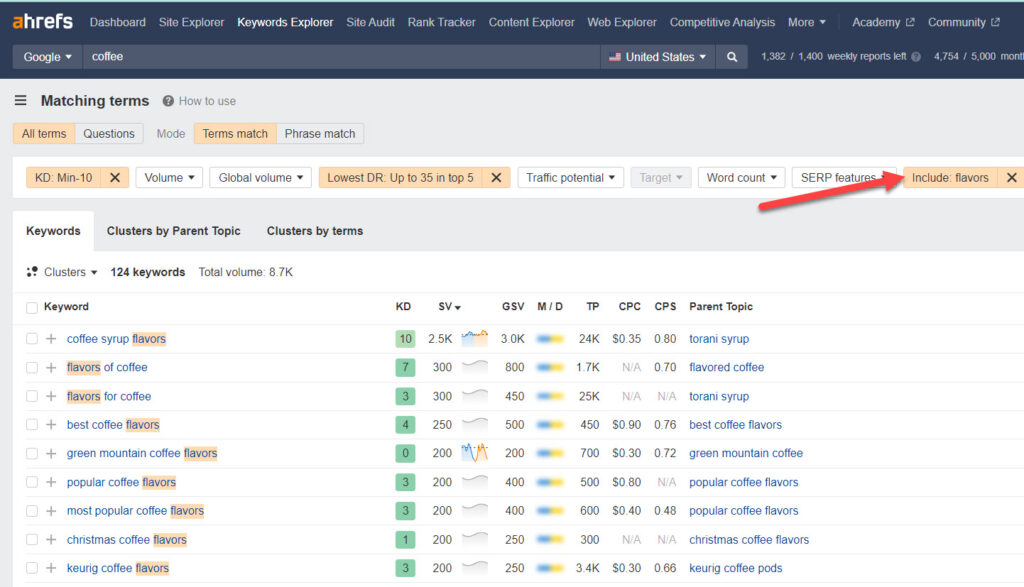
2. Utilise Long-Tail Keywords

Long-tail keywords are longer, more specific phrases that target niche demographics. They play a pivotal role in SEO because they cater to a target audience with a clear search intent. Incorporating long-tail keywords into your content increases the chances of matching specific queries, leading to quicker rankings due to less competition. They also tend to result in higher conversion rates as they precisely address user needs.
A comparison of conversion rates often shows that long-tail keywords outperform broad-head terms. While head terms might have a lower conversion rate due to their generic nature, long-tail keywords can demonstrate significantly higher conversion rates, emphasising their value in a targeted SEO content strategy. Using these keywords strategically ensures that your piece of content reaches the right audience, thereby boosting your website’s relevance and authority.
3. Optimal Keyword Placement
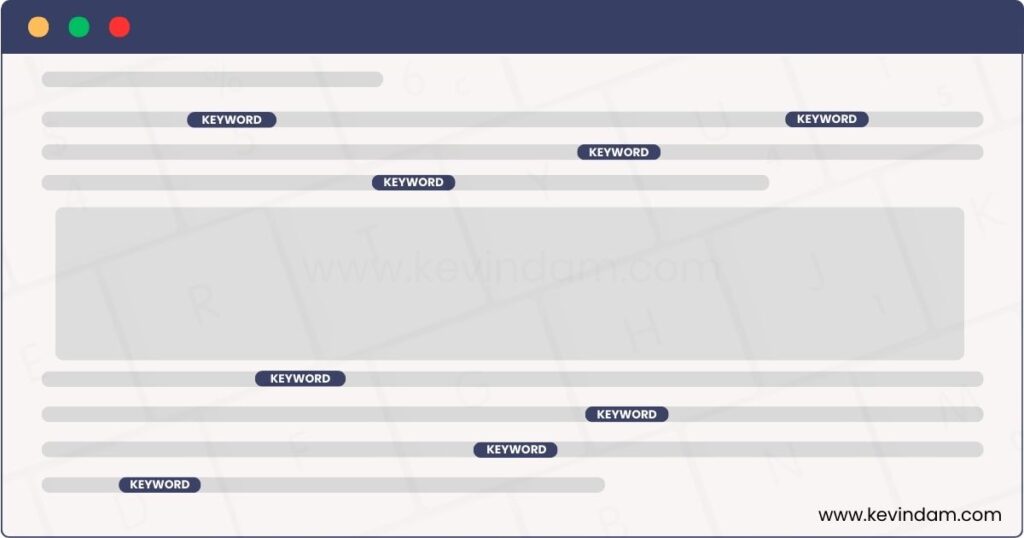
Keywords play a central role in SEO, and their strategic placement can enhance content relevance for search queries and improve rankings. Ensure to include your primary keyword and strategically integrate secondary keywords, prioritising readability and user experience to avoid keyword stuffing.
Following these SEO guidelines guarantees that your blog content is geared towards improved search rankings.
Optimal Keyword Placement in Content:
- Title Tags: Include the target keyword at the beginning of your title tag, as it holds significant weight with search engines.
- Header Tags: Use target keywords in H1 and H2 tags to signal content structure and relevance.
- Opening Paragraph: Incorporate the target keyword naturally within the first 100 words to emphasise subject focus.
- Meta Description: Craft a compelling meta description with the target keyword, summarising the content’s intent to attract clicks from search engine result pages.
Example of Keyword Placement in a Blog Post:
| Content Element | Example Placement |
| Title Tag | “10 Strategies to Master Organic Gardening” |
| Header 1 | “The Basics of Organic Gardening” |
| Opening Paragraph | “Discover essential tips for thriving in organic gardening, a sustainable method…” |
| Meta Description | “Delve into our top 10 organic gardening strategies to cultivate a flourishing green space.” |
4. Craft High-Quality, Original Content
Central to SEO is the necessity to generate content that captivates and informs—content that not only draws visitors in but also compels them to stick around and come back.
Remember that although long-form content tends to outperform short-form content, that’s not always true. High-quality content mus meet certain non-negotiable attributes; it must be original, valuable to the reader, and relevant to their queries.
Here’s a quick checklist to ensure your content measures up:
- Originality: Avoid duplicate content; offer unique insights or perspectives.
- Relevance: The content should match the search intent of your target audience.
- Engagement: Incorporate elements that promote user interaction.
- Value: Ensure the information provided solves problems or educates.
- Structure: Use headers and bullet points for easy skimming.
- Clarity: Write in a lucid style, accessible to a wide audience.
To truly excel, align your content with readers’ expectations and search engine guidelines. Remember, quality content isn’t just about what you say— it’s about how you say it and whether it resonates with those who find it.
5. Content and Search Intent Alignment
To create content that resonates with users and search engines, it’s crucial to understand and align with search intent. Search intent refers to the underlying purpose of a user’s query. There are four main types of search intent which are: informational, navigational, transactional, and commercial.
To match content with these intents effectively, consider the following alignments:
| Intent Type | Corresponding Content |
| Informational | Blog posts, how-to guides, and FAQs |
| Navigational | Brand or product-specific pages, “About” or “Contact” |
| Transactional | Product listings, services, and checkout pages |
| Commercial | Product comparisons, reviews, and sales pages |
Crafting content to match the specific intent enhances the user experience and increases the likelihood of fulfilling the user’s search needs. To ensure your content aligns with user needs, you can review the top-ranking pages for a given search term.
For instance, someone looking for “how to make coffee” (informational intent) benefits from a detailed blog post. In contrast, a search for “buy coffee maker online” (transactional intent) is best met with an e-commerce product page.
Focusing on the right type of content for each search intent allows businesses to attract more organic traffic and improve their search engine rankings.
6. Refreshing Outdated Content
Ensuring your content stays relevant is crucial for maintaining and improving search rankings. Refreshing outdated content is an effective SEO tactic that can breathe new life into your web pages, making them valuable resources for your target audience.
To update older content, start by identifying articles that are no longer current or performing well in search results. Utilise SEO tools to determine which pieces may benefit from a makeover. Once you’ve pinpointed these, use the table below to guide your refresh process:
| Content Component | Before Update | After Update |
| Relevance | Information that is outdated or less useful. | Updated data, stats, and information in line with the present context. |
| Keywords | Old or irrelevant keywords. | Integrated long-tail and relevant keywords with current search intentions. |
| User Experience | Old design, poor navigation. | Improved layout, mobile responsiveness, faster loading times. |
| Engagement | Stale meta descriptions, dull headlines. | Compelling meta descriptions, catchy and accurate headlines. |
Additionally, consider incorporating newer internal links, enriching your content with multimedia, and ensuring that your piece aligns with the most current SEO best practices. Remember, each updated article should provide high-quality and valuable content for your readers, further solidifying your SEO content strategy.
By consistently updating your content, you not only make it more useful for your readers but also signal to search engines that your site is well-maintained and authoritative, often leading to better rankings and increased organic traffic.
7. Structure Content for SEO and Readers
Properly structured content not only helps search engines efficiently crawl and index the material but also enhances the user experience, making information easily digestible.
A well-structured piece of content clearly defines its purpose through headings, subheadings, bullets, and paragraphs that are concise and to the point. This clarity helps search engines identify relevant keywords and improve search engine rankings. Meanwhile, users benefit from the ability to quickly scan content and find the information they need, which is key to retaining their engagement.
Here’s a comparison of good vs poor content structure:
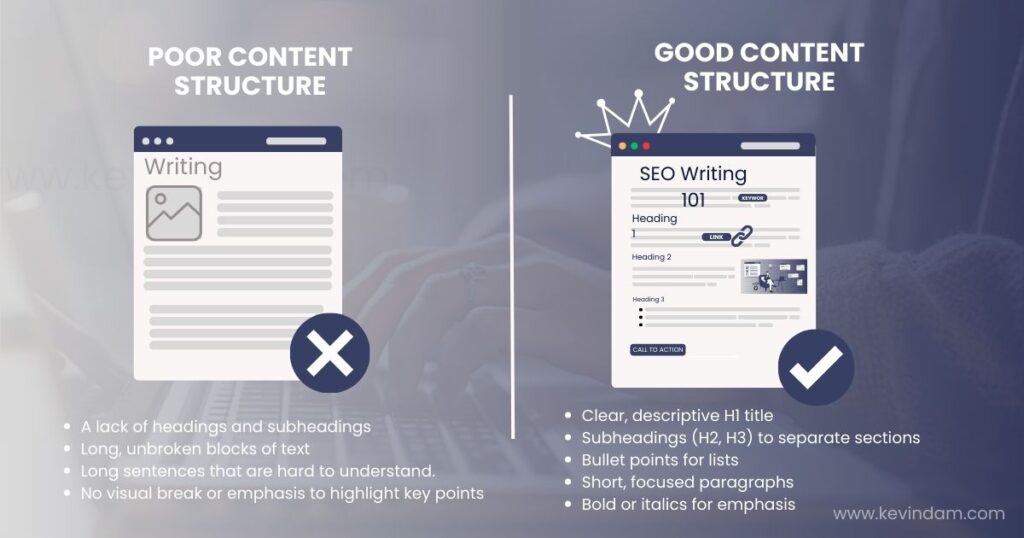
Incorporating these elements into your SEO content strategy will make your piece of content more appealing to both search engines and readers, ultimately contributing to better organic traffic and digital marketing outcomes.
8. Demonstrating E-E-A-T (Experience, Expertise, Authoritativeness, Trustworthiness)
A vital aspect of crafting SEO-friendly content is E-E-A-T, which stands for Experience, Expertise, Authoritativeness, and Trustworthiness. Demonstrating these components in your content can significantly boost trust with users and search engines, in turn, improving your search engine rankings.
Demonstrating E-E-A-T Through Content:
- Experience: Showcase real-world experiences related to the content topic. You can include case studies, personal narratives, or examples of work you have done in the field.
- Expertise: Highlight credentials, education, and deep knowledge in the subject matter through well-researched and thoughtful pieces. Including data and citing authoritative sources bolsters your expertise.
- Authoritativeness: Establish your or your brand’s authority by contributing guest posts on reputable sites in your industry and by earning backlinks from credible sources.
- Trustworthiness: Build trust by ensuring that content is fact-checked, reliable, and transparent. Displaying clear contact information and having a secure site help too.
| Element | How to Demonstrate |
| Experience | Real-life examples |
| Expertise | Credentials, in-depth research |
| Authoritativeness | Guest posts, credible backlinks |
| Trustworthiness | Fact-checking, secure website |
Infographics can be a powerful tool for visually representing these elements, making them more digestible and engaging for readers looking to understand and apply E-E-A-T in their content creation strategies.
9. Internal Linking Practices
Internal linking is a crucial strategy for SEO, as it facilitates the spread of link equity across your site, enhancing the overall search engine visibility of your pages. By strategically linking related content, you create a network that search engines can crawl through easily.
Strategies for Effective Internal Linking:
- Anchor Text: Use descriptive anchor text that gives readers and search engines context about the linked page.
- Content Relevance: Link to content that is relevant to the topic of your current piece, providing additional value to your readers.
- Link Hierarchy: Build a logical flow in your internal linking, from top-level pages down to more specific ones, guiding users deeper into your site.
- Avoid Overlinking: Keep the number of internal links on a page reasonable to not overwhelm readers or dilute link equity.
- Monitor Link Health: Regularly check for broken links to ensure a smooth user experience and consistent SEO performance.
Optimal Linking Structures (Flow Diagram):
1. Home Page
- Category Pages
- Subcategory Pages
- Individual Blog Posts/Product Pages
- Subcategory Pages
This simple diagram illustrates the hierarchy of link distribution, starting from the home page down to the most specific pieces of content. Implement these internal linking practices to strengthen your site’s SEO and improve rankings.
10. Earning Backlinks with High-Quality Content
High-quality content not only engages the target audience but also plays a pivotal role in link-building, which is essential for improving search rankings. Acquiring backlinks from credible sites will signal to Google that your website is trustworthy.
For content creators seeking to attract backlinks, here are key actions to consider:
- Create Authoritative Resources: Develop comprehensive guides or resources that become go-to references in your industry. This type of content is often cited by others, leading to natural backlinks.
- Utilise Data and Research: Original research, data-driven insights, and compelling case studies not only showcase your expertise but are also frequently linked to by writers looking to back up their points.
- Design Infographics: Visually engaging infographics that simplify complex data or processes are highly shareable and link-worthy.
Successful Backlink Campaigns at a Glance
| Campaign Type | Outcome |
| Authoritative Guides | Increased citations & industry recognition |
| Original Research | Enhanced credibility & multiple references |
| Infographics | Wide sharing & diverse backlink profiles |
Remember,
these content elements must provide value and address users’ informational intent to naturally earn backlinks from reputable sites. Strive not for mere volume but for content quality that prompts organic, unsolicited linking.
11. Craft Compelling Titles and Meta Descriptions
The right title and meta description serve as the hook for potential visitors. Their role is pivotal in enticing users to click through to your website, thus they must be crafted carefully.
Titles must be precise and engaging, containing your target keyword to signal relevance to both searchers and search engines. Keep them under 60 characters to ensure they display fully in search results. Meta descriptions, though not a direct ranking factor, influence click-through rates. A compelling description should summarise the page content effectively within 150-160 characters and include a call to action.
Consider the difference between these examples:
| Aspect | Ineffective Example | Effective Example |
| Title | Buy Shoes | Designer Shoes Sale |
| Meta Description | We sell shoes. We have many shoes for sale. | Step into style with up to 50% off designer shoes by Brand X. Discover your perfect pair and enjoy free shipping on orders over $50! |
Short paragraphs and clear, decision-driving language make for SEO-friendly content that enhances user experience and search engine rankings.
12. Optimising for Featured Snippets
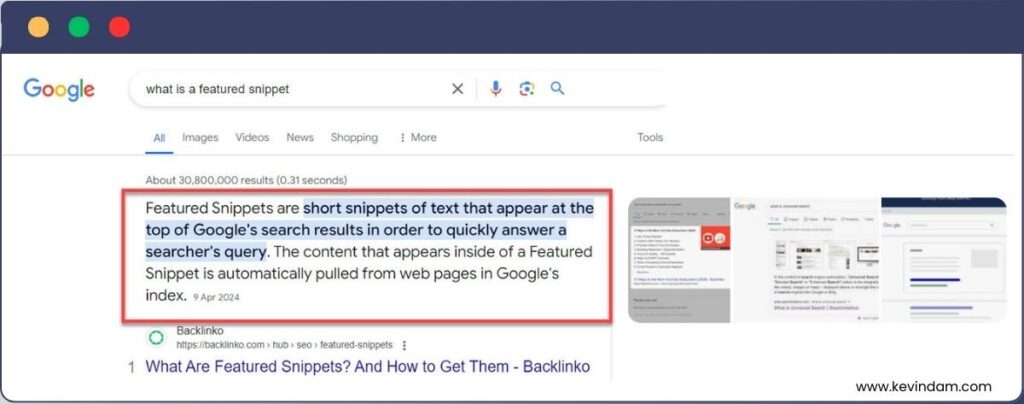
Featuring high search engine rankings can substantially boost organic traffic. One aspect of SEO, particularly relevant to enhancing visibility, involves optimising content for Google’s featured snippets.
To increase the chances of your content being selected for a featured snippet, begin with succinct, well-structured writing. Keep paragraphs short, ideally between 40 to 50 words, to improve readability and facilitate quick comprehension. Addressing the search intent directly with clear and relevant answers can enhance the content’s suitability for snippets.
Incorporate lists and tables where appropriate. For example, if the content can be broken down into steps, items, or categories, a bulleted or numbered list could make it an attractive pick for a snippet. Similarly, data or comparisons are well-suited to table format, offering easy-to-digest information at a glance.
By adhering to these guidelines, website owners can create valuable content that stands a good chance of being featured prominently at the top of search results, thus driving more organic traffic to their site.
13. Boosting Site Speed
A faster site enhances user experience and can lead to better search engine rankings. Site speed is a significant factor; slow page loading can drastically increase bounce rates.
To boost site speed, start by compressing images and utilising browser caching. Investing in better hosting can also make a noticeable difference. Another tip is to minimise the use of heavy plugins and streamline your code by removing unnecessary characters and spaces.
Improving Site Speed:
- Compress images before uploading
- Leverage browser caching
- Upgrade hosting for better performance
- Minimise the use of plugins
- Optimise and clean up website code
Impact on Bounce Rates and Rankings:
| Site Load Time (Seconds) | Bounce Rate Increase | Ranking Impact |
| 1-3 | +32% | Minimal |
| 3-5 | +90% | Noticeable |
| 5+ | +100% | Significant |
Speedier websites provide a smoother user experience, encouraging visitors to stay longer and engage more. By following these tips, you can improve your site speed, reduce bounce rates, and potentially climb the search engine rankings.
14. Core Web Vitals Optimisation
Improving search rankings can lead to more organic traffic and better user engagement. This article aims to provide practical SEO tips, focusing on optimising Core Web Vitals, which play a significant role in SEO.
Core Web Vitals are a set of metrics defined by Google that gauge the health of a website in terms of user experience. They are crucial elements impacting a site’s position in search engine results. To enhance Core Web Vitals, consider the following actionable steps:
- Optimise Largest Contentful Paint (LCP): Ensure your main content loads within 2.5 seconds to improve loading performance.
- Improve First Input Delay (FID): Strive for an FID of less than 100 milliseconds to enhance interactivity.
- Focus on Cumulative Layout Shift (CLS): Aim for a CLS score less than 0.1 for better visual stability.
| Core Web Vital | Target Threshold |
| LCP | ≤2.5s |
| FID | ≤100ms |
| CLS | ≤0.1 |
Achieving these targets contributes to an optimal user experience, favoured by search engine algorithms. Regularly monitor and fine-tune your website’s performance to stay ahead in search engine rankings.
15. Smart Use of URLs and Redirection
In SEO, the way URLs are structured and redirections are implemented can have a significant impact on a site’s search rankings.
For URL structure, simplicity is key. Keep them readable, use hyphens to separate words, and avoid lengthy strings of numbers or characters. This not only benefits user experience but also helps search engines understand the content of your page. The ideal URL should reflect the information hierarchy on the page and include relevant keywords to enhance your search rankings.
Redirection is crucial when updating your site. It’s important to redirect outdated URLs to new ones properly to maintain your SEO strength. A common mistake is creating a chain of redirects, which can slow down page load times and dilute SEO value. Here’s a quick visual breakdown of the correct way to implement redirects:
Correct Redirection Implementation: Old URL A ➔ New URL B
Incorrect Redirection Implementation: Old URL A ➔ Intermediate URL C ➔ New URL B
Always use 301 redirects to signal to search engines that the page has moved permanently. This ensures that the link equity is fully passed to the new URL, preserving your SEO efforts.
16. Utilising Google Search Console
Google Search Console is a vital tool for both businesses and website owners when it comes to mastering SEO. This powerful platform helps monitor website performance and offers many features to pinpoint areas needing SEO enhancement. In this guide, we’ll highlight key steps to use Google Search Console effectively.
First, navigate to the ‘Performance’ tab to view your website’s search data, including clicks, impressions, click-through rate (CTR), and your position in search results. Short paragraphs ensure this guide remains easily digestible.
Next, using a list format for clarity:
- Verify your site’s ownership to access all features.
- Explore the ‘Coverage’ section to identify crawl errors or issues with web pages.
- Check the ‘Mobile Usability’ report to ensure your site is mobile-friendly.
- Utilise the ‘Links’ report to review your internal and external links for optimisation opportunities.
For a practical visual aid, consider adding step-by-step guide screenshots that demonstrate each point, enhancing user comprehension.
By leveraging these features, you can derive actionable insights and make informed decisions to bolster your SEO efforts and climb those coveted search rankings.
17. Analysing Competitor Strategies
Analysing the SEO strategies of competitors is a crucial step for businesses to gain a competitive edge in search engine rankings. By delving into competitors’ tactics, website owners can uncover effective SEO practices and identify areas for improvement in their own strategies.
One essential technique is to assess high-ranking competitors’ usage of keywords, particularly long-tail keywords, to attract their target audience. Insight into their keyword density can help avoid pitfalls such as keyword stuffing, which can negatively impact SEO.
The quality and structure of content are equally important. Examining how competitors organise their internal links, meta descriptions, and types of content can provide ideas for creating more relevant, valuable content that caters to the search intent of users.
SEO tools, such as Google Analytics, offer a quantitative analysis of competitors’ organic traffic, allowing businesses to measure where they stand in terms of search volume and featured snippets.
Here’s a simplified table comparing key SEO metrics:
| Metric | Your Site | Competitor A | Competitor B |
| Organic Traffic | X visits | Y visits | Z visits |
| Keyword Rankings | X rank | Y rank | Z rank |
| Backlink Profile | X links | Y links | Z links |
| Content Quality | X score | Y score | Z score |
This table format can help visualise where improvements are needed and how competitors are excelling. Employing these insights into your SEO content strategy and digital marketing efforts can lead to enhanced user experience and better search engine rankings.
Conclusion
SEO, or Search Engine Optimisation, is crucial for businesses and website owners striving to increase their online visibility and attract more organic traffic. By applying the tips shared in this article, you stand to improve your search engine rankings and reach your target audience more effectively.
Quick Recap of SEO Tips for Better Rankings:
- Create High-Quality Content: Ensures engaging and relevant information for your audience.
- Utilise Internal Links: This helps distribute page authority and leads users to more content.
- Optimise Meta Descriptions: Encourages click-throughs from search results.
- Target Long-Tail Keywords: Caters to specific search queries and user intent.
- Prioritise User Experience: This ensures a positive interaction with your site, favoured by search engines.
- Avoid Keyword Stuffing: Maintain content quality over quantity of keywords.
- Use SEO Tools: Tools like Google Analytics can guide your content strategy.
- Aim for Featured Snippets: Position your content to be featured prominently in search results.
Implementing these actionable tips can yield significant improvements in your site’s ranking. Begin with content quality, focus on the relevance and value offered to your users, and utilise the appropriate tools to analyse and adapt your strategy. SEO is an ongoing process, and staying current with best practices is key to success in the digital marketing landscape.
